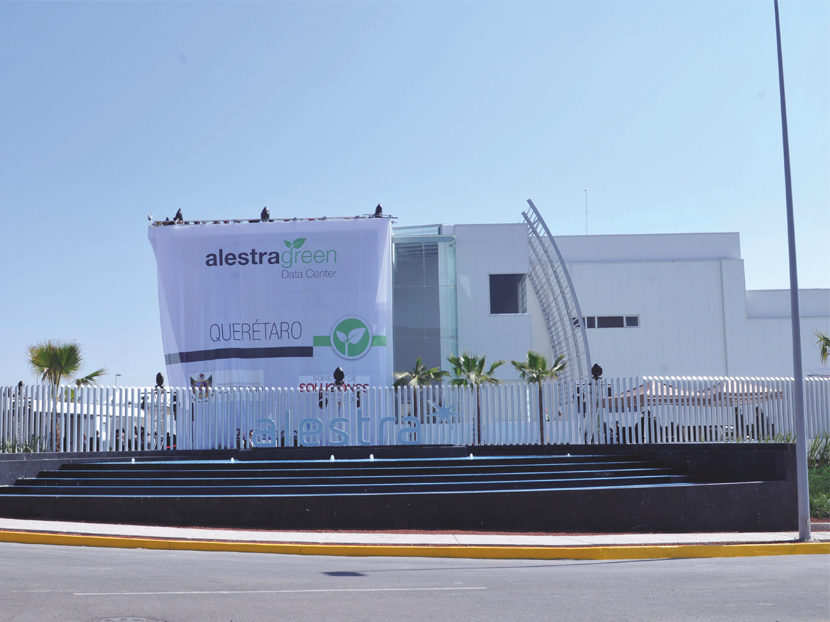Safe AND Sustainable Space for Data
Alestra Green Data Center envisions technology hubs for a greener world.

Recently, Axtel invited Especificar magazine to visit its Alestra Green Data Center, located on Queretaro’s Technological Park, with the intention to reassert the company’s commitment to sustainability. The company began the two-part data center project in 2014 and completed the final phase in July of this year.
Both data centers go further than just being a high-capacity digital information cluster; safety, as much as sustainability, have been applied concepts during the construction, and now in operation, too. “It is basic for any company to use green technology and be friendlier with the environment. Axtel is proud to have one of the best data centers in the world,” says Hector Sanchez, Critical Mission Engineering manager.
His point of view of the newly built data center mirrors the opinion of the International Computer Room Experts Association (ICREA), which supports and certifies responsible practices in data center design, construction, operation, management and maintenance. In 2016, the ICREA named the Alestra Green Data Center the “world’s best data center.”
Importance of sustainability
Sanchez says that with a growing demand for smart technology, there needs to be more storage capacity for all the information produced. “Information storage requires more physical space, which means these data centers, will need, ironically, more energy to keep information available all the time; to provide an adequate temperature to the data halls; and to avoid overheating, even for the building’s simplest procedures.”
To reduce the power needs — which according to Sanchez, is of 2,000 MW/h monthly in the Alestra Green Data Center — in 2009, Axtel adopted an “innovation culture” among its working team to improve operational processes. In 2012, it added environmental care to its practices, as well as electric power optimization. Together, these steps resulted in a three-pillar-based philosophy: quality, innovation and environmental care, all applied directly to its data center projects.
In Alestra Green Data Center, the results are grand, not only for their savings in terms of energy — which according to Sanchez, would be equivalent to the energy of 11,000 homes in Queretaro — but also because everything is part of a sustainability oriented project. This began with its location in Queretaro.
The weather in Queretaro doesn’t really require air-conditioning systems, and instead focuses on architectural design. The terrain’s unevenness was used to construct an avant-garde building. Therefore, it was decided that the equipment for the Alestra Green Data Center’s infrastructure, air conditioning and power was located in the basement, and computer rooms were all located on the first floor, what allowed for 100-percent usable spaces.
The cogeneration power system avoids energy losses during distribution (if the service was provided by the Federal Power Commission, or “CFE,” its acronym in Spanish), and it also mitigates greenhouse gas emissions. In fact, thanks to the cogeneration system, the data center is avoiding the emission of 183 tons of CO2 per month.
In regards to the cooling systems, the company chose to use natural refrigerants in the air-conditioning units, with variable speed fans, for the computer rooms and data halls. The cooling towers were also chosen carefully. They are designed to save as much water as possible. To cool the environment, the data center also makes use of a free-cooling system, which prioritizes natural ventilation to prevent the compressor ignition when it’s not needed.
This data center also has a wastewater treatment plant to clean water from the whole building. In the basement, where the plant is located, there is a filtration and purification system that treats the liquid to reuse it for irrigation and sanitary purposes.
Alestra also installed a fire protection network to protect its clients’ information and keep the site safe. The building employs early detection devices, and a mitigation system with an extinction agent that is environmentally friendly.
“The extinction agent used was FM 200, which, despite its effectiveness, is harmful for the ozone layer, as it lasts 20 years in the atmosphere,” says Luis Arizpe, Critical Mission Operation manager. That is why they chose Novec, which, in comparison with the former, is far better. It lasts five days in the atmosphere.
Arizpe adds that during phase one, which included data halls 1, 2 and 3, the fire protection systems were developed to meet ICREA’s minimum requirements for certification; however, the time between phases 1 and 2 allowed them to evaluate options and choose more efficient technologies.
Axtel has also taken measures with its fire protection network and extinction agents. Now, it has 100-percent automated options for its control center. For the electric rooms, Alestra chose clean agents and dry extinguishers, like the Vortex system, which extinguishes fire without drenching the equipment. The system is based on a combination of hydrogen and 10 micrometer-vapor particles. In fact, for data hall 8, the team is considering changing to a system like the Vortex system to protect the equipment without risking the electrical systems.
“Adjustments have been [made] due to the natural evolution of the industry, the need to comply with the NFPA standards, and to integrate a versatile engineering view that aims at the equilibrium between investment and quality systems,” Arizpe says.
In other words, due to an investment of more than $43 million, the Alestra Green Data Center has become the poster child for exemplary data center development. In addition to the recognitions and certifications from ICREA, Alestra was recently awarded the CEEDA prize from the Data Center Dynamics.
This article was originally published in our sister publication, Especificar, TMB Publications’ leading B2B Mexican magazine for plumbing, HVACR, hydronic and fire protection contractors. Especificar was launched in January 2017. Read more articles like this at especificarmag.com.mx.




